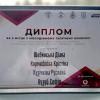Feed aggregator
Антикорупційний комікс від студенток КПІ: від ідеї до перемоги у всеукраїнському конкурсі
У молодіжному творчому конкурсі "Разом проти корупції! Твоє бачення має значення", що проводився Міністерством оборони України з нагоди Міжнародного дня боротьби з корупцією, друге місце вибороли студентки другого курсу факультету соціології і права КПІ ім.
Innoscience files lawsuits against Infineon in China
🏰 Запрошуємо на виставку «Із полумʼя зродились»
Запрошуємо на виставку «Із полумʼя зродились» у КПІ ім. Ігоря Сікорського, яку присвячено українським військовим, волонтерам та медикам!
Мистецтво лікує. Майстер-класи "Малюй з воїном"
Люди, які зіткнулися з травматичними подіями – стали свідками або учасниками війни, терористичних актів, природних катастроф чи насильства, – можуть мати проблеми із психікою. За даними Всесвітньої організації охорони здоров'я, кожна п'ята особа, яка мала травматичний досвід, потребує психологічної реабілітації. Одним із дієвих методів роботи з психотравмами є арттерапія.
📣 Команда «Прозорих міст» росте, розвивається та пропонує одразу аж три круті вакансії!
Наразі шукають:
Nvidia, TSMC, and advanced packaging realignment in 2025

Nvidia’s CEO Jensen Huang has made waves by saying that his company’s most advanced artificial intelligence (AI) chip, Blackwell, will transition from CowoS-S to CoWoS-L advanced packaging technology. That also shows how TSMC’s advanced packaging technology—chip on wafer on substrate (CoWoS)—is evolving to overcome interconnect battles inside large, powerful chips for AI and other high-performance computing (HPC) applications.
The CoWoS-S advanced packaging technology uses a single silicon interposer and through-silicon vias (TSVs) to facilitate the direct transmission of high-speed electrical signals between the die and the substrate. However, single silicon interposers often confront yield issues.
On the other hand, CoWoS-L, TSMC’s latest packaging technology, uses a local silicon interconnect (LSI) along with an RDL interposer to form a reconstituted interposer (RI) to enhance chip design and packaging flexibility. It also preserves the attractive feature of CoWoS-S in the form of TSVs while mitigating the yield issues arising from the use of large silicon interposers in CoWoS-S.
According to Reuters, Nvidia is selling its Blackwell chips as quickly as TSMC can manufacture them, but packaging has become a bottleneck due to capacity constraints. That’s startling because, as Huang noted, the amount of advanced packaging capacity at TSMC is probably four times the amount available less than two years ago.

Figure 1 CoWoS-L marks a significant advancement over CoWoS-S in terms of performance and efficiency for AI and HPC applications. Source: TSMC
Huang also told Taiwanese reporters that Nvidia is still producing Blackwell’s predecessor, Hopper, using TSMC’s CoWoS-S advanced packaging technology. “It’s not about reducing capacity. It’s actually increasing capacity into CoWoS-L.”
Advanced packaging in flux
Nvidia’s foray into new technology is a stark reminder of how quickly advanced packaging needs are changing. Apparently, the semiconductor industry is eying a new set of advanced packaging building blocks to dramatically increase the bandwidth and interconnect density of AI chips.
TSMC’s CoWoS is a 2.5D semiconductor packaging technology that increases the number of I/O points while reducing interconnect length between logic and memory components. However, emerging HPC workloads, particularly those related to AI training, demand even higher memory bandwidth due to frequent memory accesses.
CoWoS-L can stack up to 12 HBM3 devices at a lower cost than CoWoS-S and thus has the potential to become the mainstream CoWoS technology for future AI chips. Beyond CoWoS-L, TSMC is warming up to co-packaged optics (CPO), which replaces traditional electrical signal transmission with optical communications.

Figure 2 TSMC has made significant progress in its silicon photonics strategy by integrating CPO with advanced semiconductor packaging. Source: TrendForce
The current AI chips use copper interconnects, which increasingly face bottlenecks as bandwidths widen. In CPO, optical interconnect signals can achieve higher bandwidth than their electrical counterparts. For instance, CPO supports up to 1.6 Tbps bandwidth, which is 1.8 times wider than Gen 4 NVLink interconnect used by Nvidia in its current GPUs. Moreover, power consumption is also up to 50% lower.
According to Taiwanese media outlet UDN, TSMC has completed the development of CPO, and it plans to provide CPO samples to two of its major customers, Broadcom and Nvidia, later this year. Furthermore, UDN reports that TSMC plans to scale up the production of CPO in 2026.
AI chips constituting high logic-to-logic and logic-to-memory bandwidth are driving innovations in the advanced packaging realm. The move from CoWoS-S to CoWoS-L and the advent of CPO are harbinger of this pivot in the semiconductor industry ecosystem, which is now increasingly driven by AI applications.
Related Content
- Advanced Packaging and Chiplets Can Be for Everyone
- TSMC crunch heralds good days for advanced packaging
- After TSMC fab in Japan, advanced packaging facility is next
- Understanding the Big Spend on Advanced Packaging Facilities
- Advanced IC Packaging: Fundamentals for the ‘More than Moore’ Era
The post Nvidia, TSMC, and advanced packaging realignment in 2025 appeared first on EDN.
LED lantern with the diffuser removed
 | submitted by /u/4b686f61 [link] [comments] |
This is by far one of the most difficult and ugliest thing I ever built
 | This is a Nixie tube clock I built without using any PCB boards. Basically, it was built via point to point wiring. This thing is far from perfect: it’s all crooked, numbers don’t line up, etc. but I think that’s the allure of building something like this. This will never be perfect. Something like this cannot be built by automation. No 2 clocks will never be identical; if I decided to build another clock like this, I will never build it exactly like this one. This thing is still not perfect; it is failing the self test routine and need to still debug the driver circuits of one of the nixies. It’s almost there though! I’m planning to give my grandfather the ugly nixie clock. It’s something very personal I built with my own hands. He’s in Hawaii, so I’m an ocean away from him. I wish I could visit him every day, but that would be a long daily commute (from California to O’ahu). He doesn’t have much time left on this planet, however, he was the very one that molded me into what I am today. He’s going to get a nixie clock, only one of it’s type in the entire world lol This build was pretty stressful and frustrating, but I absolutely loved every minute of it. [link] [comments] |
Ok i know this is trivial, but wow!
 | I wanna start by saying: I literally just started this hobby today. I know this is an egregiously simple thing and nothing impressive, but holy crap this brought me unbelievable levels of dopamine! I have to say this is one of the coolest things I've done in a long time. Being able to solve some equations and then build this little circuit, and watch the EXACT calculations i came up with pop up on the multimeter is amazing I've done lots of math in my day, but MAN, being able to calculate something on paper then see those results in the real world is simply amazing [link] [comments] |
scope upgrade: happy birthday to me!
 | submitted by /u/mikeblas [link] [comments] |
Weekly discussion, complaint, and rant thread
Open to anything, including discussions, complaints, and rants.
Sub rules do not apply, so don't bother reporting incivility, off-topic, or spam.
Reddit-wide rules do apply.
To see the newest posts, sort the comments by "new" (instead of "best" or "top").
[link] [comments]
Swathi Weapon Locating Radar: A Beacon of Indian Defense Technology
India has steadily emerged as a formidable force in defense technology, with indigenous innovations taking center stage. Among its crowning achievements is the Swathi Weapon Locating Radar (WLR), a state-of-the-art radar system designed to detect and track enemy artillery, mortars, and rockets. Developed by Indian defense engineers, the Swathi radar underscores India’s self-reliance in defense capabilities, offering world-class performance at a competitive cost.
What is Swathi Weapon Locating Radar?Swathi Weapon Locating Radar (WLR) is an advanced radar system designed to locate the origin of hostile artillery fire and pinpoint the location of enemy weapons. It provides critical real-time data to armed forces, enabling them to neutralize threats effectively. The radar has been a game-changer for India’s military and has garnered international attention for its capabilities.
Developed by Indian ExpertiseSwathi WLR was developed indigenously by the Electronics and Radar Development Establishment (LRDE), a division of the Defence Research and Development Organisation (DRDO), in collaboration with Bharat Electronics Limited (BEL). This collaboration brought together cutting-edge radar technology and indigenous manufacturing expertise, resulting in a highly reliable and efficient system tailored to the needs of the Indian Armed Forces.
Swathi Radar: Full Form and SignificanceThe term “Swathi” does not have a conventional acronymic full form; it is a name that symbolizes vigilance and precision. In the context of military technology, it signifies the radar’s ability to scan, detect, and act with unparalleled accuracy, much like its namesake.
Swathi’s significance lies in its ability to act as a force multiplier. By detecting and neutralizing threats before they can cause damage, the radar enhances the strategic and tactical advantage of armed forces in conflict scenarios. It also reduces the dependency on foreign-made radar systems, contributing to India’s ‘Make in India’ initiative.
Technical Features and CapabilitiesThe Swathi Weapon Locating Radar boasts several cutting-edge features that make it a world-class system:
- Detection Range: Swathi WLR has a range of up to 50 kilometers for locating artillery and up to 30 kilometers for detecting mortars and rockets. This extended range ensures early threat detection and effective countermeasures.
- Coverage Area: The radar can simultaneously track multiple targets over a wide area, making it ideal for use in complex battlefield scenarios.
- Accuracy: With high precision, the radar can pinpoint the location of enemy weaponry, providing critical data for swift retaliatory action.
- Mobility: Mounted on a mobile platform, the radar can be rapidly deployed in different terrains, from deserts to mountainous regions.
- Weather Resilience: The radar performs reliably under varied weather conditions, ensuring uninterrupted operation during critical missions.
Swathi WLR is not just a domestic asset; it has also made its mark on the international stage. India’s defense exports have grown significantly, with Swathi being a flagship product. Notably, Armenia has procured the radar system, recognizing its exceptional capabilities and cost-effectiveness. This export marked a significant milestone for India’s defense industry, positioning Swathi as a competitive alternative to systems offered by countries like the United States, Israel, and Russia.
The successful export of Swathi underscores the global recognition of India’s indigenous defense technology. It also reflects India’s growing capability to design and manufacture advanced systems that meet international standards.
Cost-Effectiveness: A Strategic Advantage
One of Swathi’s most compelling aspects is its affordability. Priced significantly lower than similar systems from other countries, Swathi offers an attractive option for nations looking to bolster their defense capabilities without overshooting their budgets. The radar’s competitive pricing, combined with its high performance, has made it an appealing choice for several countries exploring modern defense solutions.
Operational Impact and Applications
Swathi WLR has proven invaluable in enhancing battlefield operations. Here’s how:
- Threat Neutralization: By detecting the source of enemy artillery, the radar allows forces to respond quickly and effectively, neutralizing threats before they escalate.
- Border Security: Deployed along sensitive borders, Swathi provides constant surveillance and tracking, ensuring robust national security.
- Counter-Battery Fire: The radar’s ability to accurately locate enemy firing positions enables counter-battery operations, minimizing damage and ensuring tactical superiority.
- International Peacekeeping: Swathi can be deployed in international peacekeeping missions, where its precision and reliability contribute to maintaining stability in conflict zones.
Future Prospects and Upgrades
To maintain its edge, Swathi radar is expected to undergo periodic upgrades, incorporating advancements in radar and sensor technologies. Future iterations may include enhanced range, better integration with command-and-control systems, and AI-driven analytics for real-time decision-making.
Additionally, with an increasing focus on exports, DRDO and BEL are likely to develop customized versions of Swathi to meet the specific needs of different countries.
Conclusion
The Swathi Weapon Locating Radar is a testament to India’s strides in indigenous defense technology. Combining cutting-edge features with cost-effectiveness, it has become a valuable asset for both domestic and international applications. Its successful deployment and export highlight India’s potential to be a global leader in defense innovation. As Swathi continues to evolve, it will undoubtedly remain a cornerstone of India’s defense strategy and a beacon of technological excellence.
The post Swathi Weapon Locating Radar: A Beacon of Indian Defense Technology appeared first on ELE Times.
5G vs LPWA Technologies: A Comparative Overview of 5G, NB-IoT, Sigfox, and LoRa IoT
The Internet of Things (IoT) continues to revolutionize industries by enabling seamless connectivity among devices, sensors, and systems. The choice of communication technology is critical in determining the efficiency, scalability, and cost-effectiveness of IoT implementations. Among the most prominent technologies are 5G and Low Power Wide Area (LPWA) networks, which include NB-IoT, Sigfox, and LoRa. Each of these technologies has distinct characteristics, making them suitable for specific use cases. This article explores the differences between 5G and LPWA technologies, highlighting their unique features, advantages, and limitations.
Understanding the Basics5G Technology
5G is the fifth generation of mobile network technology, designed to provide ultra-fast data speeds, minimal latency, and support for massive device connectivity. It is a versatile technology catering to diverse applications, from enhanced mobile broadband (eMBB) to ultra-reliable low-latency communication (URLLC) and massive machine-type communication (mMTC).
Low Power Wide Area (LPWA) Technologies
LPWA technologies, such as NB-IoT, Sigfox, and LoRa, focus on low power consumption, wide coverage, and cost-efficiency. These technologies are tailored for IoT applications requiring long battery life, low data rates, and devices distributed over vast areas.
Key Features and Capabilities| Feature | 5G | NB-IoT | Sigfox | LoRa |
| Data Speed | Up to 10 Gbps | Up to 250 kbps | 100 bps to 600 bps | 0.3 kbps to 50 kbps |
| Latency | 1 ms or less | ~1.5 seconds | ~10 seconds | ~1 to 5 seconds |
| Coverage | Urban and dense environments | Deep indoor and rural | Global (through operators) | Regional (private networks) |
| Power Efficiency | Moderate | High | Very High | Very High |
| Cost | High | Low to moderate | Low | Low |
Comparing the Technologies
- 5G: High-Speed and Versatility
5G excels in high-bandwidth applications requiring real-time responsiveness. It is ideal for:
- Autonomous Vehicles: Low latency ensures real-time decision-making for self-driving cars.
- Smart Cities: 5G supports dense sensor deployments, enabling smart traffic systems and public safety applications.
- Industrial Automation: Ultra-reliable low-latency communication (URLLC) facilitates advanced robotics and precision manufacturing.
However, 5G’s advanced capabilities come at a higher cost. Its infrastructure demands significant investment, and its power consumption is relatively high, making it less suitable for battery-powered IoT devices.
2. NB-IoT: Simplified Cellular Connectivity
Narrowband IoT (NB-IoT) is a cellular-based LPWA technology developed to address the needs of IoT applications requiring low power consumption and wide coverage. Key applications include:
- Smart Utilities: NB-IoT is widely used in smart metering for water, gas, and electricity.
- Agriculture: It supports soil moisture sensors and livestock monitoring systems.
- Asset Tracking: NB-IoT enables cost-effective tracking of shipping containers and equipment.
NB-IoT operates within the licensed spectrum, ensuring minimal interference and reliable connectivity. Its power efficiency allows devices to run for years on a single battery. However, its data speed and latency are not sufficient for applications requiring real-time responsiveness.
3. Sigfox: Global Connectivity at Low Cost
Sigfox is a proprietary LPWA technology designed for simplicity and affordability. Operating in the unlicensed ISM band, it focuses on:
- Environmental Monitoring: Sigfox supports sensors for air quality, weather, and water levels.
- Smart Logistics: It enables tracking of pallets and packages globally.
- Security Systems: Sigfox connects low-power intrusion sensors and alarms.
Sigfox’s ultra-low data rates and power consumption make it ideal for applications transmitting small amounts of data sporadically. However, its reliance on Sigfox operators limits flexibility and scalability compared to open standards.
4. LoRa: Flexibility and Decentralization
LoRa (Long Range) is an open standard LPWA technology operating in the unlicensed ISM band. It is particularly valued for its:
- Private Networks: LoRa enables businesses to establish their own IoT networks without relying on third-party operators.
- Agriculture and Environmental Use: LoRa supports monitoring of farmlands, forests, and wildlife habitats.
- Smart Buildings: LoRa connects HVAC systems, lighting controls, and security sensors.
LoRa’s flexibility and cost-effectiveness make it a popular choice for localized IoT deployments. However, its reliance on gateways and lack of native global coverage can be limitations for some use cases.
Selecting the Right TechnologyThe choice between 5G and LPWA technologies depends on the specific requirements of the IoT application.
| Consideration | Best Technology |
| High-speed data transfer | 5G |
| Battery life and power efficiency | Sigfox, LoRa, NB-IoT |
| Global connectivity | Sigfox |
| Private network setup | LoRa |
| Real-time responsiveness | 5G |
The Future of IoT Connectivity
As IoT ecosystems continue to expand, hybrid approaches integrating multiple technologies are emerging. For example, 5G can provide high-speed backbone connectivity, while LPWA networks handle localized low-power tasks. Additionally, advancements in edge computing and AI are enhancing the capabilities of all these technologies, enabling more intelligent and efficient IoT solutions.
Conclusion5G and LPWA technologies each bring unique strengths to the IoT landscape. While 5G is the backbone of high-performance, real-time applications, LPWA technologies like NB-IoT, Sigfox, and LoRa cater to cost-sensitive, low-power use cases. The diversity of these technologies ensures that IoT can address a wide spectrum of needs, driving innovation across industries and transforming how we interact with the world around us.
The post 5G vs LPWA Technologies: A Comparative Overview of 5G, NB-IoT, Sigfox, and LoRa IoT appeared first on ELE Times.
Іноземні студенти обирають навчання у КПІ ім. Ігоря Сікорського!
Нещодавно відбувся черговий випуск студентів–іноземців і 67 студентів з різних держав світу, серед яких, зокрема, 🇨🇳 Китай, 🇪🇬 Єгипет та 🇪🇨 Еквадор, отримали дипломи магістрів нашого університету.








